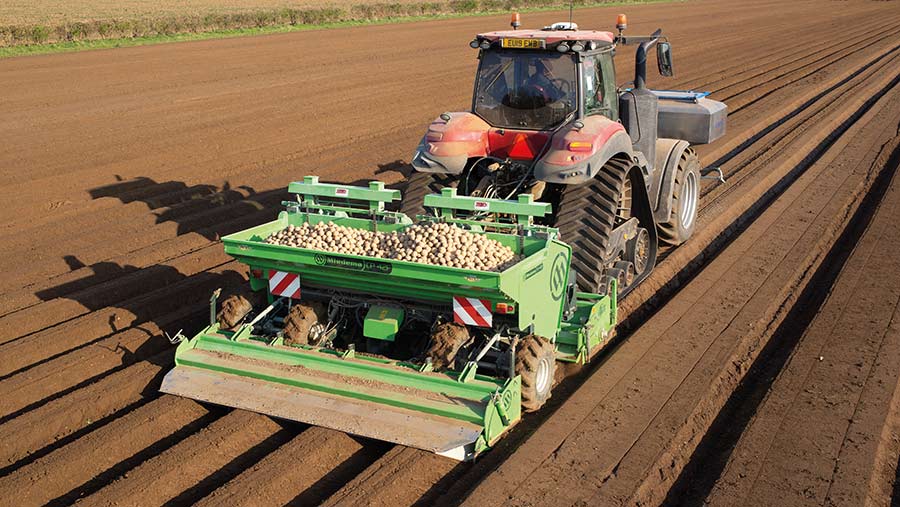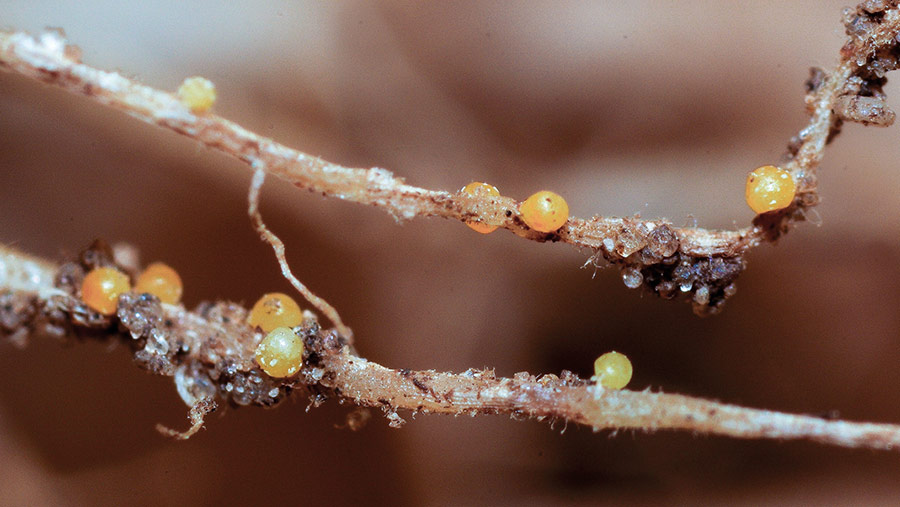How breeding can help farmers manage PCN in potatoes
 © Tim Scrivener
© Tim Scrivener A breeding collaboration searching for new marketable spud varieties showing resistance and high tolerance to potato cyst nematode have put forward five promising candidate clones for National List testing.
Grampian Growers, E Park & Sons and Skea Organics – known as the GPS partnership – plus commercial research group James Hutton Institute have been developing new potato varieties in England since 2016.
These trials have been designed to screen new resistant clones for best tolerance against potato cyst nematode (PCN). This has been achieved by planting in soils with high populations of the predominant PCN species in Britain, Globodera pallida, and with no chemical treatment applied.
See also: All you need to know about controlling wireworm in potatoes
E Park & Sons company agronomist Pip Blaylock has been overseeing the English farm trials since 2014, when the GPS breeding programme started with some 40,000 seedlings. These were whittled down to just 13 possessing the desired traits for a final examination in 2020.
Across sites in Scotland and five sites in England, last year’s trials tested the 13 on a range of soil types and for end use requiring commercial agronomy plans to maximise output and test their tolerance to PCN populations on specific sites.
Ms Blaylock says the work provided some robust data, confirming much of her previous observations and helped identify five outstanding candidates that will be entered into National List testing in 2021. This must be completed before a variety can be sold commercially.
“The grower requires a robust variety that reduces multiplication of cysts in the soil, yet must also be very tolerant so it produces excellent yields and quality.”

© Blackthorn Arable
Population reductions
The group now believes it has three varieties that produce an excellent fresh table or baking potato, a crisping variety and also a salad variety (see “GPS’s top five PCN-resistant/tolerant varieties for National List testing”).
Each one can provide a far better economic return to the farmer through their high tolerance, which leads to higher yields and better and bolder tuber samples and, in the longer term, a reduction in PCN control costs.
An assessment of their effect on PCN in the soil has also demonstrated good results in exclusively G pallida populations.
PCN often occurs in small patches, making it notoriously difficult for researchers to set up replicated trials to compare varieties fairly.
To overcome this, the main north Lincolnshire trial site in 2020 was selected for its potentially homogenous population of G pallida PCN across the plots, allowing each variety to be objectively assessed for its effect of the pest in the soil. The field selection proved pivotal in 2020.
The effect of host varieties on PCN populations is measured using a population final (pf/pi) population initial factor, established by testing soils before and after a crop is grown.
If this is below a factor of 1, then the variety will reduce the population and, if above 1, it will enable PCN to multiply.
Ms Blaylock says the G pallida-resistant GPS candidates tested have a pf/pi factor ranging between 0.38 and 1.12 so, at worst, the population sees a marginal increase, but the best can crash a population below half of its starting position, simply by growing a crop of potatoes.
“Some established commercial table varieties returned pf/pi factors between four and 18, so at a starting point of just four eggs or larvae/g of soil, the PCN population would multiply in a range of 16 to 72 eggs or larvae/g.
“However, the new G pallida-resistant GPS clones tested would range between 1.6 to four eggs or larvae/g, even without any crop protection products applied. This is clearly a good result and one that potentially reduces the burden of PCN for the farmer year on year,” she explains.
Conventional methods
All GPS varieties are produced using conventional breeding techniques, namely the crossing of pollen and flowers to produce true seed. The seed is then planted and seedlings screened for desirable traits.
This process has been accelerated by gene mapping methods that check if selected clones contain the unique genetic markers for desirable traits, saving years of trials work and significant resource.
Ms Blaylock says with no genetic modification (GM) or gene editing involved, the programme is producing material acceptable to both organic and conventional potato growers, allowing wider use across the potato sector.
With the loss of the granular nematicide Vydate (oxamyl) announced just before Christmas, growers are left with very limited chemical options for nematode control in root crops, making the GPS and other breeding efforts ever more critical for future potato production in the UK.
“Everyone is working hard to improve potato production towards a sustainable future. For example, we also have other breeders’ material in these trials, helping to identify more potential PCN-resistant and -tolerant clones.
“However, resistance alone isn’t the solution, and it must be coupled with robust tolerance traits, enabling the plant to shrug off the attack as the cysts hatch in the presence of the potato crop,” she adds.
This is because tolerance of PCN larvae feeding allows its roots to develop strongly before resistance kicks in and stops the female nematodes developing into cysts, breaking the pest’s lifecycle – a trait some of the new potential GPS varieties have.
Integrated strategy
This should see these varieties, and those from other breeders, become a core part of integrated crop management (ICM) strategies designed to minimise the effect of the crop’s most important pest.
Many growers with high levels of PCN have – like on the selected GPS trial sites – an exclusively G pallida population after many sequential plantings of varieties such as Maris Piper.
Maris Piper has been the most widely grown variety for many years and its very good PCN tolerance and resistance to the other main species of PCN, G rostochiensis, has been the main cause of selecting for these high-G pallida populations across the British potato area.
In the future, Ms Blaylock believes sequential plantings of new GPS clones and established varieties such as Maris Piper could be used as part of a “pull-push” concept, which would alternate varieties with slightly different resistance profiles in a rotation.
In theory, this will reduce the risk of selecting for new, more aggressive PCN types that are harder to control through long-term use of the same genetics, instead encouraging lower and less-problematic mixed populations of G pallida and G rostochiensis species.
Essentially, this keeps the well-known and well-understood “bad guys” in a place where they can be managed more easily with the appropriate variety sequence. This would need to be backed up by careful mapping, monitoring and speciation of each field.
“Perhaps growers will no longer be exclusively fresh table or processing potato producers, but use the varieties with differing attributes wisely as they move to a true ICM system,” says Ms Blaylock.
GPS’s top five PCN-resistant/tolerant varieties for National List testing |
||
|
Numbered clone |
Market |
Key traits |
|
Clone 1 |
Table baker |
Dual PCN Ro (H1) and Pa (H3) |
|
Clone 2 |
Crisper |
Dual PCN Ro (H1) and Pa (H3) |
|
Clone 3 |
Table baker/chipper |
Single PCN Pa (HC) |
|
Clone 4 |
Table baker |
Single PCN Ro (H1) |
|
Clone 5 |
Salad |
Single PCN Ro (H1) |

